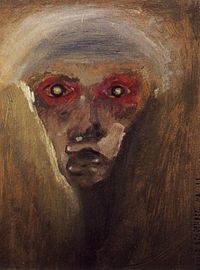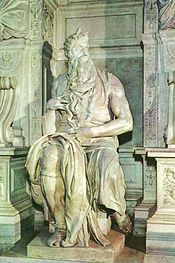- Moses und Aron
-
Arnold Schoenberg  Operas
Operas- Erwartung (1924)
- Die glückliche Hand (1924)
- Von heute auf morgen (1930)
- Moses und Aron (unfinished)
Moses und Aron (English: Moses and Aaron) is a three-act opera by Arnold Schoenberg with the third act unfinished. The German libretto was by the composer after the Book of Exodus.
Contents
Compositional history
Moses und Aron has its roots in Schoenberg's earlier agitprop play, Der biblische Weg (The Biblical Way, 1926–27), which represents a response in dramatic form to the growing anti-Jewish movements in the German-speaking world after 1848 and a deeply personal expression of his own "Jewish identity" crisis. The latter began with a face-to-face encounter with anti-Semitic agitation at Mattsee, near Salzburg, during the summer of 1921, when he was forced to leave the resort because he was a Jew, although he actually converted to Protestantism in 1898. It was a traumatic experience to which Schoenberg would frequently refer, and of which a first mention appears in a letter addressed to Kandinsky (April 1923): "I have at last learnt the lesson that has been forced upon me this year, and I shall never forget it. It is that I am not a German, not a European, indeed perhaps scarcely even a human being (at least, the Europeans prefer the worst of their race to me), but that I am a Jew."[1]
Schoenberg's statement echoed that of Mahler, a convert to Catholicism, some years earlier: "I am thrice homeless: as a Bohemian among Austrians, as an Austrian among the Germans, and as a Jew throughout the entire world. I am an intruder everywhere, welcome nowhere."[2]
 Schoenberg Der Rote Blick (Red Gaze), 1910.
Schoenberg Der Rote Blick (Red Gaze), 1910.
The Mattsee experience was destined to change the course of Schoenberg's life and to influence his musical creativity, leading him first to write Der Biblische Weg, in which the central protagonist Max Aruns (Moses-Aaron) is partially modelled on Theodor Herzl, the founder of modern political Zionism; then, to proclaim in Moses und Aron his uncompromising monotheistic creed; and finally, upon his official return to Judaism in 1933, to embark for more than a decade on a relentless mission to save European Jewry from impending doom. Der Biblische Weg should be considered as both a personal and political play. Moses, at the center of the biblical Exodus story had become from the time of Heine to that of Herzl and Schoenberg, the ideal incarnation of a national and spiritual redeemer.[1]
From the sketchy outline of the play (1926) to its final version (1927) and to the inception of Moses und Aron as an oratorio (1928) and then into an opera, it was composed between 1930 and 1932. Despite its unfinished status it is widely regarded as Schoenberg's master work.
(Note: Schoenberg's title may have omitted an "A" in Aaron's name because the composer was a severely superstitious triskaidekaphobe.[3] "Moses und Aaron" would have caused the title to have a total of 13 letters.)
Zoltán Kocsis (Hungarian conductor, composer and pianist) had received permission from Schoenberg's heirs in 2009 to complete the last act, and his version was to be premiered in Budapest on 16 January 2010.[4]
Performance history
As Schoenberg always intended to finish the work, the opera was not performed during his lifetime. However, the first public performance of music from the opera was a performance of Der Tanz um das goldene Kalb in concert at Darmstadt on 2 July 1951, just 11 days before the composer's death.[5][6] There was a concert performance of the two acts in Hamburg on 12 March 1954 with Hans Herbert Fiedler as Moses and Helmut Krebs as Aron, conducted by Hans Rosbaud. The first staging was in Zurich at the Stadttheater on 6 June 1957, again with Hans Herbert Fiedler as Moses and conducted by Hans Rosbaud, but with Helmut Melchert as Aron.
Georg Solti conducted the first performance at the Royal Opera House, London on 28 June 1965. The singers were Forbes Robinson (Moses) and Richard Lewis (Aron). The American premiere was produced by Sarah Caldwell's Opera Company of Boston on 30 November 1966 with Donald Gramm, as Moses, Richard Lewis as Aron, Harry Theyard as the young man, Maxine Makas as the young girl, Eunice Alberts as the invalid woman, and Osbourne McConathy conducting.[7] (The Metropolitan Opera did not stage it until 1999.)
In 1973, the work was also made into a film by Jean-Marie Straub and Danièle Huillet (although not released in the US until 1975). A 2006 production by the Vienna State Opera survives in DVD form.
Music
Moses and Aron is based entirely on a single tone row, itself constructed from cells:
This row is then combined with versions of itself so that the first half of each still provide six different pitches:
Roles
Role Voice type Premiere cast, 12 March 1954
(Conductor: Hans Rosbaud)Moses speaker Hans Herbert Fiedler Aron tenor Helmut Krebs Young girl soprano Ilona Steingruber-Wildgans Youth tenor Helmut Kretschmar Ephraimite baritone Hermann Rieth Sick woman alto Ursula Zollenkopf Man baritone Horst Günter Naked youth tenor Hartwig Stuckmann Priest bass Hermann Rieth First naked virgin soprano Dorothea Förster-Georgi Second naked virgin soprano Karla Maria Pfeffer-Düring Third naked virgin alto Annemarie Tamm Fourth naked virgin alto Charlotte Betcke Man speaker Six solo voices in the orchestra soprano, mezzo-soprano, altos,
tenor, baritone, bassDorothea Förster-Georgi, Maria Üger,
Ursula Zollenkopf, Hartwig Stuckmann,
Horst Sellentin, Ernst Max LührVoice from the burning bush, 70 elders, beggars, several elderly persons, 12 tribal leaders, other naked persons, dancers and supernumeraries of all kinds Numbered scenes
 Michelangelo Moses
Michelangelo Moses
Act I:
- Scene 1 (The Calling of Moses): 'Einziger, ewiger, allgegenwärtiger'
- Scene 2 (Moses meets Aaron in the Desert): 'Du Sohn meines Vaters'
- Scene 3 (Moses and Aaron brought God's Word to the People): 'Ich hab' ihn gesehn'
- Scene 4 (The Escape from Egypt): Bringt ihr Erhörung'
Act II:
- Prelude (Waiting for Moses): 'Wo ist Moses?'
- Scene 1 (Aaron and the 70 Elders Stand in front of the Mountain of Revelation): 'Vierzig Tage liegen wir nun schon hier!'
- Scene 2 (The Impatient People): 'Wo ist Moses?'
- Scene 3 (Dance round the Golden Calf): 'Dieses Bild bezeugt'
- Scene 4 (Moses descends from the Mountain): 'Moses steigt vom Berg herab'
- Scene 5 (Moses denounces Aaron): 'Aron, was hast du getan?'
Act III (Late in Schoenberg's life, the third act is unfinished as said above. It has only one scene.)
- Scene 1 (Aaron's Demise)
Instrumentation
The work is scored for the following orchestra:
- woodwind: 3 flutes (2nd and 3rd doubling on piccolo), 3 oboes, English horn, 3 clarinets (3rd doubling on sopranino clarinet), bass clarinet, 3 bassoons (3rd doubling on contrabassoon);
- brass: 4 horns, 3 trumpets, 3 trombones, bass tuba;
- percussion: timpani, glockenspiel, xylophone, flexatone, bells in A, B flat, f and c', bass drum, cymbals, tam-tam, gong, big tenor drum, small drum, tambourine, ratchet, bells of undefined pitch;
- Other: 2 mandolins, celesta, piano, harp, strings;
- On-stage: English horn, horn, 2 trumpets, 2 trombones, 2 mandolins, 2 guitars (T. 929-957), bass drum - more thuds, cymbals, sleigh bells, gongs in various pitches (T. 1084-1098 and T. 1102-1127), 3 clarinets, 3 horns or 3 bassoons (T. 1082-1128);
- Behind the stage: piccolo, flute, clarinet, trombone, timpani, xylophone, 2-4 mandolins, piano (T. 1084-1098 and T. 1102-1109)
Recordings
- 1954: Hans Herbert Fiedler, Helmut Krebs, Sinfonieorchester des Nordwestdeutscher Rundfunk (Hamburg) conducted by Hans Rosbaud
- 1966: Josef Greindl, Helmut Melchert, conducted by Hermann Scherchen
- 1973: Günter Reich, Louis Devos, Chor und Sinfonieorchester des Ósterreichischen Rundfunks conducted by Michael Gielen
- 1975: Günter Reich, Richard Cassilly, BBC Symphony Orchestra conducted by Pierre Boulez
- 1976: Werner Haseleu, Reiner Goldberg, Rundfunk-Sinfonie-Orchester Leipzig conducted by Herbert Kegel
- 1984: Franz Mazura, Philip Langridge, Chicago Symphony Orchestra and Chorus conducted by Georg Solti; Grammy Award for Best Opera Recording in 1986.
- 1996: David Pittman-Jennings, Chris Merritt, Royal Concertgebouw Orchestra conducted by Pierre Boulez
- 2006: Wolfgang Schöne, Chris Merritt, Stuttgart State Orchestra conducted by Roland Kluttig
References
- Notes
- ^ a b Tugendhaft, Aaron, 1997, "Schoenberg’s Moses und Aron," The Chicago Undergraduate Journal of Jewish Studies, Vol. 3, Spring
- ^ Mahler, Alma, 1975, Gustav Mahler: memories and letters, tr. Basil Creighton, ed. Donald Mitchell, 3rd ed., p. 109, Seattle: University of Washington Press. ISBN 0295953780
- ^ Ross, Alex, 2007, The Rest Is Noise, p. 200. Farrar, Straus and Giroux.
- ^ New Schoenberg score stolen in Hungary
- ^ Neighbour, O.W.: "Moses und Aron", Grove Music Online ed. L. Macy (Retrieved on 12 February 2009), <http://www.grovemusic.com>
- ^ Ross, 2007, The Rest is Noise, p. 351.
- ^ Kessler, Daniel, 2008, Sarah Caldwell: First Woman of Opera, Scarecrow Press, at google books
- ^ Whittall, Arnold, 2008, The Cambridge Introduction to Serialism, p. 230. New York: Cambridge University Press. ISBN 978-0-521-68200-8 (pbk).
- ^ Whittall, 2008, The Cambridge Introduction to Serialism, p. 103.
External links
Categories:- Operas by Arnold Schoenberg
- German-language operas
- Operas
- Unfinished operas
- 1932 operas
- Twelve tone compositions
- Operas based on the Bible
Wikimedia Foundation. 2010.

